Stop Building AI Agents. Use These 5 Patterns Instead.
Master the workflow patterns that solve 95% of production problems.
Welcome to the AI Agents Foundations series—a 9-part journey from Python developer to AI Engineer. Made by busy people. For busy people.
Everyone’s talking about AI agents. But what actually is an agent? When do we need them? How do they plan and use tools? How do we pick the correct AI tools and agentic architecture? …and most importantly, where do we even start?
To answer all these questions (and more!), We’ve started a 9-article straight-to-the-point series to build the skills and mental models to ship real AI agents in production.
We will write everything from scratch, jumping directly into the building blocks that will teach you “how to fish”.
What’s ahead:
The 5 Workflow Patterns ← You are here
Multimodal Data
By the end, you’ll have a deep understanding of how to design agents that think, plan, and execute—and most importantly, how to integrate them in your AI apps without being overly reliant on any AI framework.
Let’s get started.
Opik: Open-Source LLMOps Platform (Sponsored)
This AI Agents Foundations series is brought to you by Opik - the LLMOps open-source platform used by Uber, Etsy, Netflix and more.
But most importantly, we are incredibly grateful to be supported by a tool that we personally love and keep returning to for all our open-source courses and real-world AI products. Why? Because it makes escaping the PoC purgatory possible!
Here is how Opik helps us ship AI workflows and agents to production:
We see everything - Visualize complete traces of LLM calls with costs and latency breakdown at each reasoning step.
Easily optimize our system - Measure our performance using custom LLM judges, run experiments, compare results and pick the best configuration.
Catch issues fast - Plug in the LLM Judge metrics into the production traces and get on-demand alarms.
Stop manual prompt engineering - Their prompt versioning and optimization features allow us to track and improve our system automatically. The future of AutoAI.
Opik is fully open-source and works with custom code or most AI frameworks. You can also use the managed version for free (w/ 25K spans/month on their generous free tier).
The 5 Workflow Patterns
When building Brown, my writer assistant capstone project for the AI Agents course, I built together with Towards AI, I faced a critical challenge. The first iteration worked. It could generate articles. But it was slow, expensive, and the user experience was poor. More importantly, when I tried to rewrite it from scratch for better performance, I realized something crucial: the system was trying to do too much in a single, massive LLM call. One prompt was responsible for understanding content, following structure, matching tone, and generating diagrams. When something went wrong, I could not pinpoint where. This experience taught me that complex AI systems need to be broken down, but how?
A single, large LLM call for a complex task is often problematic. It makes pinpointing errors difficult, lacks modularity, and increases the likelihood of “lost in the middle” issues where the model ignores information in long contexts [1]. You might think that when a single prompt fails, you should jump straight to AI Agents. But that is a trap.
Jumping to agents is often overkill for deterministic tasks. Most workflows have predictable steps. Agents add unnecessary complexity with their autonomous decision-making when you just need reliable execution. They introduce too many moving parts to debug, leading to unpredictable costs and reliability issues.
When building agents, here is what actually happens at scale: the agent ignores your tools, the summarizer ignores your instructions, and the coordinator gets lost in all the options. Most agent systems break down from too much complexity, not too little.
The smarter approach is to start with simpler, more controllable patterns. Before considering agents, you should try to solve your problem using these five core workflow patterns:
Prompt Chaining
Parallelization
Routing
Orchestrator-Worker
Evaluator-Optimizer
Let’s start by examining the most fundamental of these patterns: prompt chaining.
The Power of Modularity: Chain Specialized LLM Calls
Prompt chaining is the fundamental pattern of every workflow. It involves connecting multiple LLM calls or other processing steps sequentially, where the output of one step becomes the input for the next. This divide-and-conquer approach is a more manageable solution for complex tasks. By breaking a large problem into smaller, focused sub-tasks, each LLM call has a clearer, more constrained objective. This improves reliability, as simpler prompts are less likely to confuse the model or lead to incomplete results.
Chaining offers several benefits. It improves modularity, as each LLM call focuses on a specific, well-defined sub-task. This leads to enhanced accuracy because simpler, targeted prompts generally yield more reliable outputs. Debugging becomes easier since you can isolate issues to specific links in the chain. It also increases flexibility, allowing individual components to be swapped or optimized independently. For instance, you could use a cheaper, faster model for a simple classification step and a more powerful model for complex generation [2], [3].
For our writing workflow, we can chain several steps to produce a final article: creating media assets, generating the article text, crafting a title, and then producing SEO metadata.
However, chaining has downsides. Some instructions may lose meaning when split across multiple steps, and context can be lost between prompts. This approach also increases costs and latency due to multiple LLM calls. Furthermore, if one step in the chain fails, the entire workflow can break, requiring proper error handling.
In theory, this pattern sounds sooo simple you think it’s a no brainer. But in reality, there is a lot of experimentation until you find the sweet spot on how much you should divide your prompts.
For example, here is a high-level Python example illustrating the chaining pattern for our writing workflow:
def writing_workflow(research_and_intent: str) -> dict:
“”“
A sequential workflow for generating an article.
“”“
# Step 1: Create media assets based on the initial input
media_assets = create_media_assets(research_and_intent)
# Step 2: Generate the article using the assets and the initial input
article_draft = generate_article(research_and_intent, media_assets)
# Step 3: Generate a title for the draft
title = generate_title(article_draft)
# Step 4: Generate SEO metadata for the final article
seo_metadata = generate_seo(article_draft, title)
return {
“title”: title,
“article”: article_draft,
“seo”: seo_metadata
}While chaining provides modularity and control, its sequential nature can create bottlenecks. The next logical step is to identify independent tasks within our workflow and execute them in parallel to improve speed and efficiency.
Optimize Your Sequential Workflows With Proper Parallelization
While a sequential workflow is reliable, it can be slow. We can optimize it by running independent steps in parallel to reduce the total processing time. Parallelization simply means running as many steps as possible concurrently, as long as they do not depend on each other’s outputs. This is particularly effective for tasks like data extraction from multiple sources or, in our case, generating various media assets at once.
This pattern is useful when tasks can be processed independently. However, it can introduce challenges like race conditions or timeouts. It is also important to be mindful of API rate limits, as making many concurrent calls can lead to errors. LLM APIs such as Gemini, OpenAI or Claude often have limits, known as Requests Per Minute (RPM) quotas, which must be managed in a production application [4], [5]. Thus, your application should handle these gracefully, by running a maximum number of jobs in parallel using async semaphors, thread pools or retry strategies with exponential backoff.
In our writing workflow example, we can generate all the required media assets—like diagrams and images—in parallel. After initiating all tasks, the system waits for them to complete and can retry any that fail.
The following code shows how to implement this using Python’s asyncio library:
import asyncio
async def parallel_media_generation(research_and_intent, max_concurrent=3):
“”“
Generates all media assets in parallel with concurrency control.
“”“
asset_types = [”diagram”, “image_1”, “image_2”, “image_3”, “image_4”]
# Create a semaphore to limit concurrent operations
semaphore = asyncio.Semaphore(max_concurrent)
async def generate_with_limit(asset_type):
“”“Wrapper to control concurrency with semaphore.”“”
async with semaphore:
# Only max_concurrent tasks will execute simultaneously
return await generate_media_asset(asset_type, research_and_intent)
# Create a list of tasks to run concurrently (but controlled by semaphore)
tasks = [generate_with_limit(atype) for atype in asset_types]
# Wait for all tasks to complete
media_assets = await asyncio.gather(*tasks)
# Here you could add logic to retry failed tasks
return media_assetsParallelization is effective for uniform, independent tasks, but not all workflows are so straightforward. Often, the path forward depends on the nature of the input itself, requiring a more dynamic approach.
Dynamic Decisions: Routing and Conditional Logic
Not all inputs should be processed in the same way. Routing, or conditional logic, addresses this by directing the workflow down different paths based on the input or an intermediate state. Think of it as a smart if-else statement where an LLM acts as a classifier to make branching decisions. This keeps prompts specialized and follows the “divide-and-conquer” principle, ensuring that each part of your workflow is optimized for a specific type of task.
Routing is ideal when you have distinct categories of inputs that require different handling. For example, a customer support tool could route queries to specialized handlers for technical support, billing, or general questions [6], [7], [8]. This is preferable to optimizing a single, monolithic prompt for multiple input types, where often optimizing for one use case degrades the performance on others.
A critical best practice is to include a default or catch-all route to handle unexpected cases gracefully. This ensures your system is robust and can manage inputs that do not fit neatly into predefined categories.
For our writing workflow, we can use a router to decide which type of media to generate based on the user’s intent. An LLM classifier determines if the user wants a diagram, an image, or a video, and calls the appropriate generation function.
💡 Tip: For simple classification tasks like routing, using smaller, faster, and cheaper language models is a great way to optimize your workflow [9].
This Python code demonstrates how routing can be implemented:
def routing_workflow(user_intent):
“”“
Routes the request to the correct media generator.
“”“
media_type = classify_media_intent(user_intent)
if media_type == “diagram”:
return generate_diagram(user_intent)
elif media_type == “image”:
return generate_image(user_intent)
elif media_type == “video”:
return generate_video(user_intent)
else:
# Fallback for unknown types
return handle_default(user_intent)Routing manages predefined paths, but what if the tasks themselves need to be defined dynamically? This leads us to a more advanced pattern.
Dynamic Task Decomposition: The Orchestrator-Worker
The orchestrator-worker pattern is a more advanced approach that combines routing with parallel processing. A central LLM, the orchestrator, dynamically breaks down a complex task into smaller sub-tasks and delegates them to specialized workers, which can run in parallel [10], [11], [12], [13].
The key difference from simple parallelization is that the number and type of the sub-tasks required to run are determined dynamically at runtime based on the input.
On a similar note, it’s different from simple routing because it “classifies” each sub-task individually, rather than a single if-else path.
The pattern is very similar to the Map-Reduce strategy from data engineering, where we have multiple jobs running in parallel, while we aggregate the result at the end. It’s similar, but with LLMs into the mix that determine what jobs should be run.
The main point of failure of this pattern is when the orchestrator creates the wrong jobs, or jobs with the wrong arguments, or not enough/too many jobs.
For our writing workflow, an orchestrator can analyze the user’s intent and generate a list of media generation jobs. An executor then takes these jobs and runs them in parallel.
💡 Tip: Implement the set of possible jobs as “tools.” The orchestrator can then output multiple tool calls with their corresponding arguments, which the executor can run in parallel.
For example, this is how the pattern looks in Opik, where we can see all the mermaid_diagram_generator_tool calls, together with the cost, latency, token usage, inputs and outputs of each step. Beautiful!
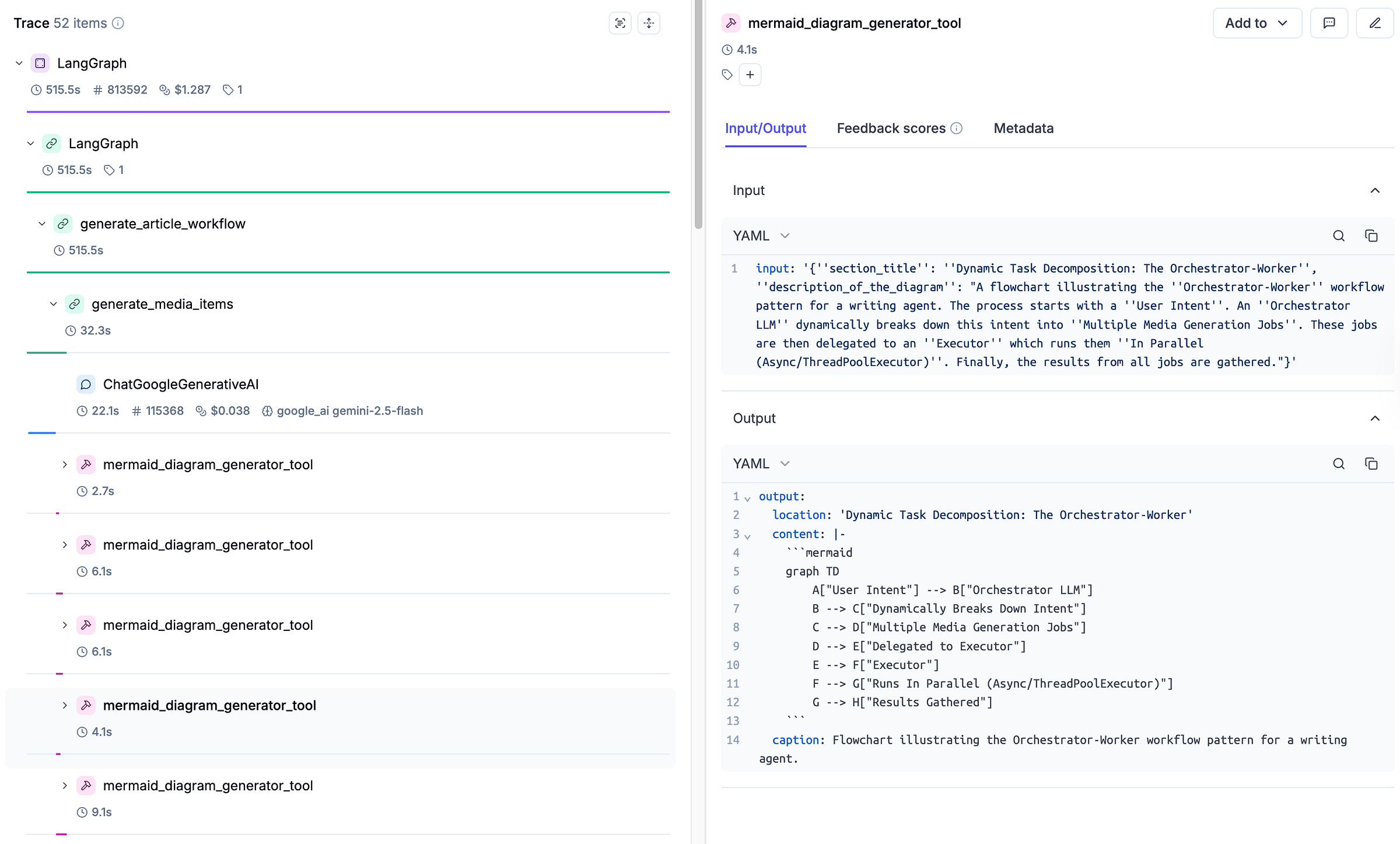
Here is how this pattern could look in Python:
from concurrent.futures import ThreadPoolExecutor
# Mock available tools
TOOLS = {
“generate_diagram”: lambda prompt: f”Diagram generated: {prompt}”,
“generate_image”: lambda prompt: f”Image generated: {prompt}”,
“generate_video”: lambda prompt: f”Video generated: {prompt}”,
}
class LLM:
“”“Mocked LLM class.”“”
@staticmethod
def call(user_intent, tools):
“”“
Mocked LLM call that returns tool calls based on user intent.
In reality, this would be a call to OpenAI, Anthropic, etc.
“”“
# Mock logic to simulate LLM deciding which tools to call
tool_calls = []
if “chart of performance” in user_intent:
tool_calls.append({
“tool”: “generate_diagram”,
“arguments”: {”prompt”: “Generate performance chart”}
})
if “photo of the team” in user_intent:
tool_calls.append({
“tool”: “generate_image”,
“arguments”: {”prompt”: “Find team photo”}
})
return tool_calls
def orchestrator(user_intent):
“”“Orchestrator that calls the LLM with available tools.”“”
return LLM.call(user_intent=user_intent, tools=TOOLS)
def worker(tool_call):
“”“Worker that executes a single tool call.”“”
tool_name = tool_call[”tool”]
tool_function = TOOLS[tool_name]
return tool_function(**tool_call[”arguments”])
def orchestrator_worker_workflow(user_intent):
“”“
Manages the orchestrator and workers to generate media.
“”“
# 1. Orchestrator generates tool calls via LLM
tool_calls = orchestrator(user_intent)
# 2. Workers execute tool calls in parallel
with ThreadPoolExecutor() as executor:
results = list(executor.map(worker, tool_calls))
return results
# Example usage:
user_request = “Create a chart of performance and find a photo of the team”
outputs = orchestrator_worker_workflow(user_request)
# outputs: [”Diagram generated: Generate performance chart”,
# “Image generated: Find team photo”]So far, our patterns have focused on executing tasks efficiently. But what about ensuring the quality of the final output? The next pattern introduces a feedback loop to do just that.
Make LLMs Autocorrect Themselves: The Evaluator-Optimizer
The evaluator-optimizer pattern is the closest we get to agent-like behavior while still maintaining a structured workflow. It creates a feedback loop to automatically improve and refine the output of an LLM. This is an effective pattern when output quality matters more than speed.
The system typically consists of a few key components [14]: 1. A generator LLM produces an initial output. 2. An evaluator LLM assesses the output against predefined criteria, generating a score and an improvement plan. 3. The generator takes the feedback from the evaluator to refine the output. 4. This loop repeats until a certain quality score is met or a maximum number of iterations is reached.
The main failure mode for this pattern is an infinite optimization loop. Therefore, it is a best practice to set clear stop conditions, such as a well-tweaked stop threshold or a maximum number of retries.
A more advanced implementation that applies the divide and conquer patterns we just learned uses multiple specialized evaluators. For instance, one evaluator could check for logical correctness, another for readability, and a third for syntax. This multifaceted feedback provides a more comprehensive critique.
In our writing workflow, we can use this pattern to refine an article draft. The generator produces the text, and an evaluator provides feedback on clarity, tone, and structure. The generator then revises the draft based on this feedback until it meets our quality standards.
As shown for the orchestrator-worker pattern, in Image 7, you can see how this pattern looks in Opik, along with its multimodal inputs, which are text and images in this use case. For example, in this trace, we had 2 iterations of: generating the article, reviewing it and editing it.
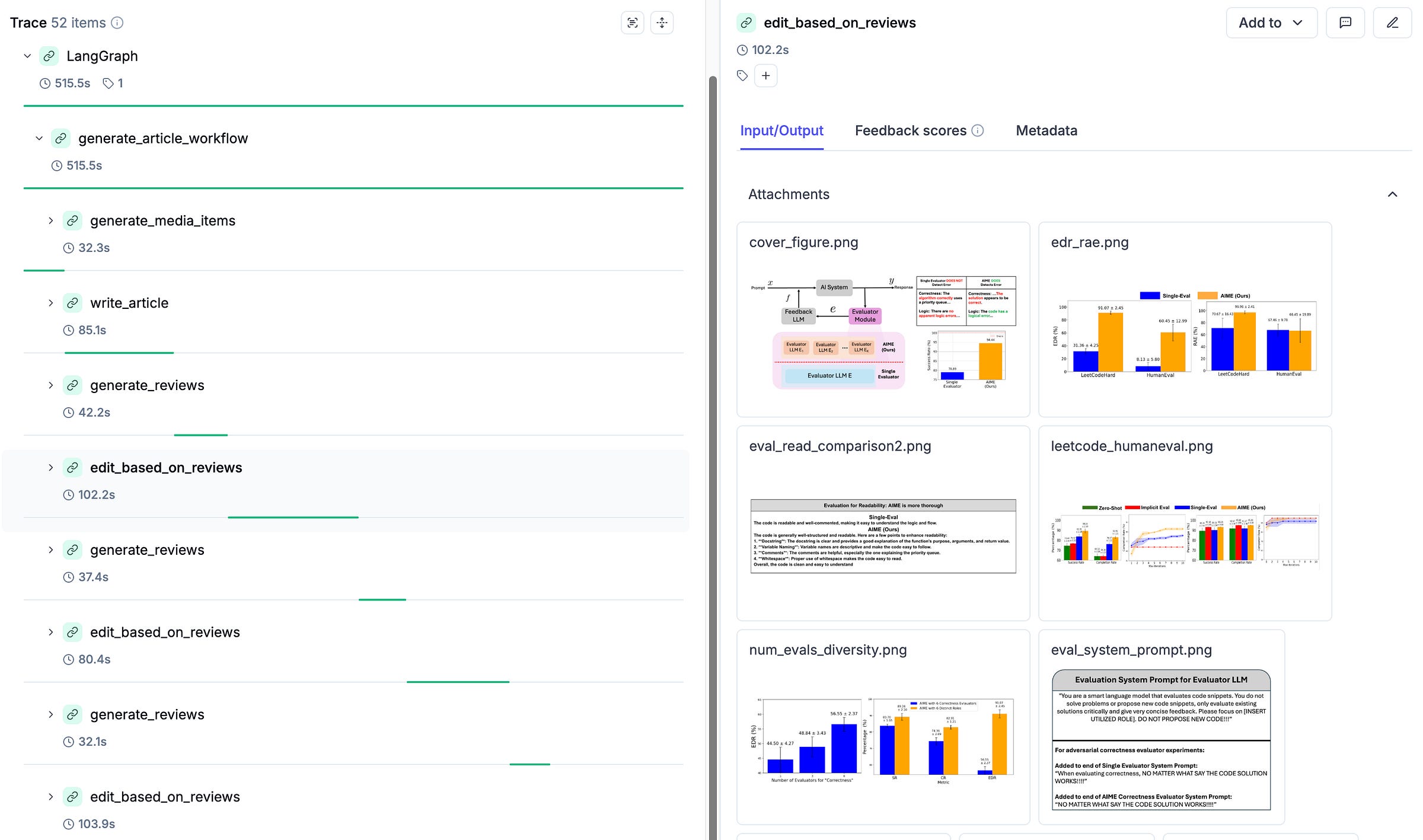
This code demonstrates the evaluator-optimizer loop:
def generator(prompt, feedback=None):
“”“Generates an article draft.”“”
if feedback:
prompt += f”\nIncorporate this feedback: {feedback}”
return llm_call(prompt)
def evaluator(article_draft):
“”“Evaluates the draft and provides a score and feedback.”“”
evaluation = llm_evaluator_call(article_draft) # Returns score and feedback text
return evaluation[”score”], evaluation[”feedback”]
def evaluator_optimizer_workflow(initial_prompt):
“”“
Iteratively refines an article until it meets quality standards.
“”“
max_iterations = 3
score_threshold = 0.8
article = generator(initial_prompt)
for i in range(max_iterations):
score, feedback = evaluator(article)
if score >= score_threshold:
print(”Quality threshold met. Finalizing article.”)
return article
print(f”Iteration {i+1}: Score={score}. Refining article with feedback.”)
article = generator(initial_prompt, feedback)
print(”Max iterations reached. Returning the latest version.”)
return articleStop Building AI Agents. Always Start With These 5 Patterns.
With these five patterns, you can solve most of the real-world problems you will encounter when building AI applications. Choosing to build a full-fledged agent should be your last resort, reserved for when simpler, more controllable methods fail.
That’s why I fell in love with this mantra vetted by
: “Most use cases don’t need agents. They need better workflows.”The strategy is simple:
Start with the simplest solution (a single prompt).
If it works, stop.
If it does not, try these five workflow patterns.
Only if all patterns fail, consider agents.
Remember that this article is part of a longer series of 9 pieces on the AI Agents Foundations that will give you the tools to morph from a Python developer to an AI Engineer.
Here’s our roadmap:
The 5 Workflow Patterns ← You just finished this one.
Tools ← Move to this one
Multimodal Data
See you next week.
What’s your take on today’s topic? Do you agree, disagree, or is there something I missed?
If you enjoyed this article, the ultimate compliment is to share our work.
How can I help
Want to learn how to build from scratch AI apps, such as the Brown writing workflow?
Join the waitlist for our latest course on Agentic AI Engineering, where you will learn to design, build, evaluate, and deploy sophisticated, production-grade AI agents and workflows. Done with Decoding AI’s builder mentality, the course consists of 30+ lessons, with code and theory, during which you will build a real-world AI product that you can show off during your interviews. Done in partnership with Towards AI.
⏰ The course will be released in early January 2026.
Thanks again to Opik for sponsoring the series and keeping it free!
If you want to monitor, evaluate and optimize your AI workflows and agents:
References
Liu, N. F., Lin, K., Hewitt, J., Paranjape, A., Bevilacqua, M., Petroni, F., & Liang, P. (2023). Lost in the Middle: How Language Models Use Long Contexts. arXiv preprint arXiv:2307.03172. https://arxiv.org/abs/2307.03172
(n.d.). Multi-LLM routing strategies for generative AI applications on AWS. Amazon Web Services. https://aws.amazon.com/blogs/machine-learning/multi-llm-routing-strategies-for-generative-ai-applications-on-aws/
(n.d.). Model selection guide. OpenAI Cookbook. https://cookbook.openai.com/examples/partners/model_selection_guide/model_selection_guide
(n.d.). Gemini API Rate Limits. Google AI for Developers. https://ai.google.dev/gemini-api/docs/rate-limits
(n.d.). Generative AI on Vertex AI quotas and system limits. Google Cloud. https://cloud.google.com/vertex-ai/generative-ai/docs/quotas
(n.d.). Python Client for Google’s Generative AI Models. Google API Python Client. https://googleapis.github.io/python-genai/
(n.d.). Welcome to the Gemini API Cookbook. GitHub. https://github.com/google-gemini/cookbook
(n.d.). Gemini API Reference. Google Cloud. https://cloud.google.com/vertex-ai/generative-ai/docs/model-reference/inference
(n.d.). Technical analysis of routing strategies in LLM-based systems. arXiv. https://arxiv.org/html/2502.00409v2
Schluntz, E., & Zhang, B. (n.d.). Building effective agents. Anthropic. https://www.anthropic.com/research/building-effective-agents
(n.d.). Workflows and Agents. LangChain. https://langchain-ai.github.io/langgraphjs/tutorials/workflows/
(n.d.). AI agent design patterns. Azure Architecture Center. https://learn.microsoft.com/en-us/azure/architecture/ai-ml/guide/ai-agent-design-patterns
(n.d.). Mixture of Agents. Microsoft AutoGen. https://microsoft.github.io/autogen/stable/user-guide/core-user-guide/design-patterns/mixture-of-agents.html
Patel, B., Chakraborty, S., Suttle, W. A., Wang, M., Bedi, A. S., & Manocha, D. (2024). AIME: AI System Optimization via Multiple LLM Evaluators. arXiv preprint arXiv:2410.03131. https://arxiv.org/html/2410.03131v3
Images
If not otherwise stated, all images are created by the author.



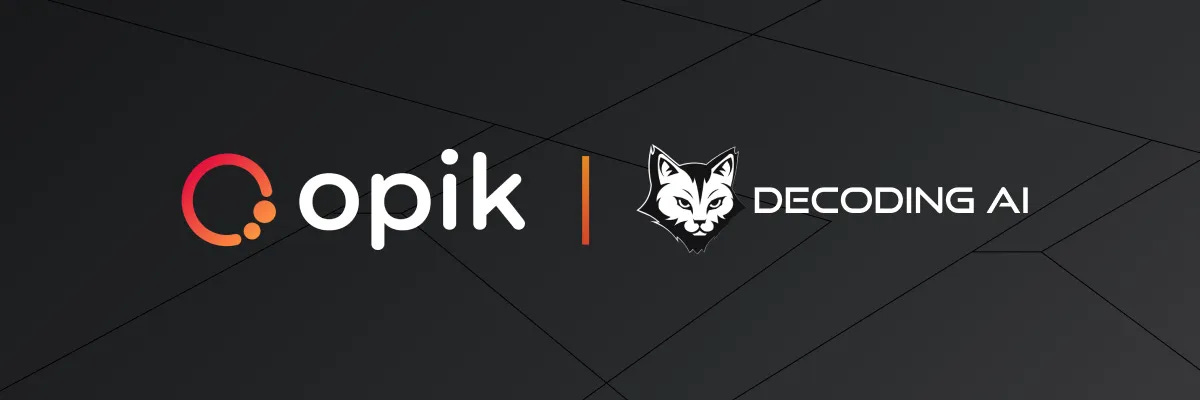
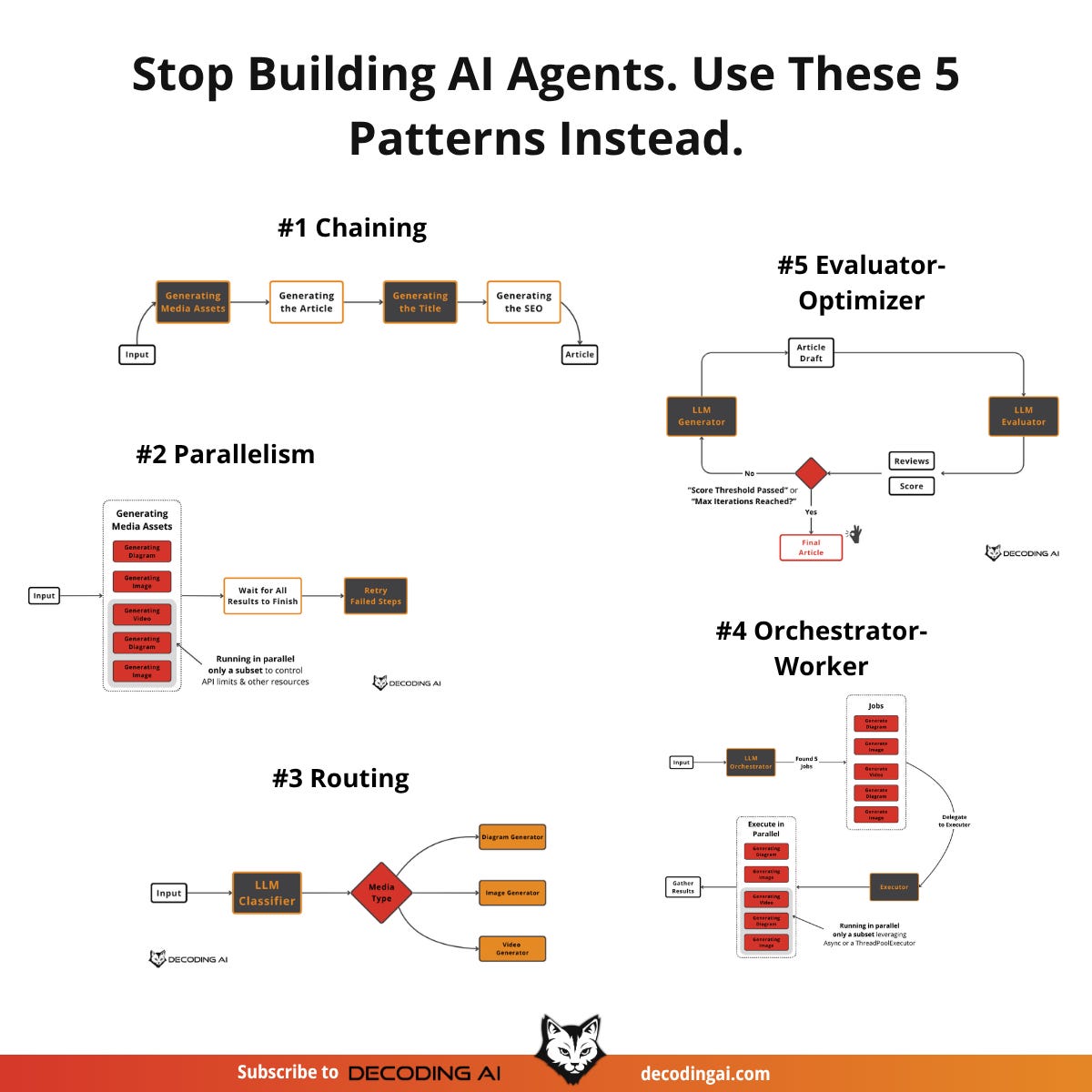

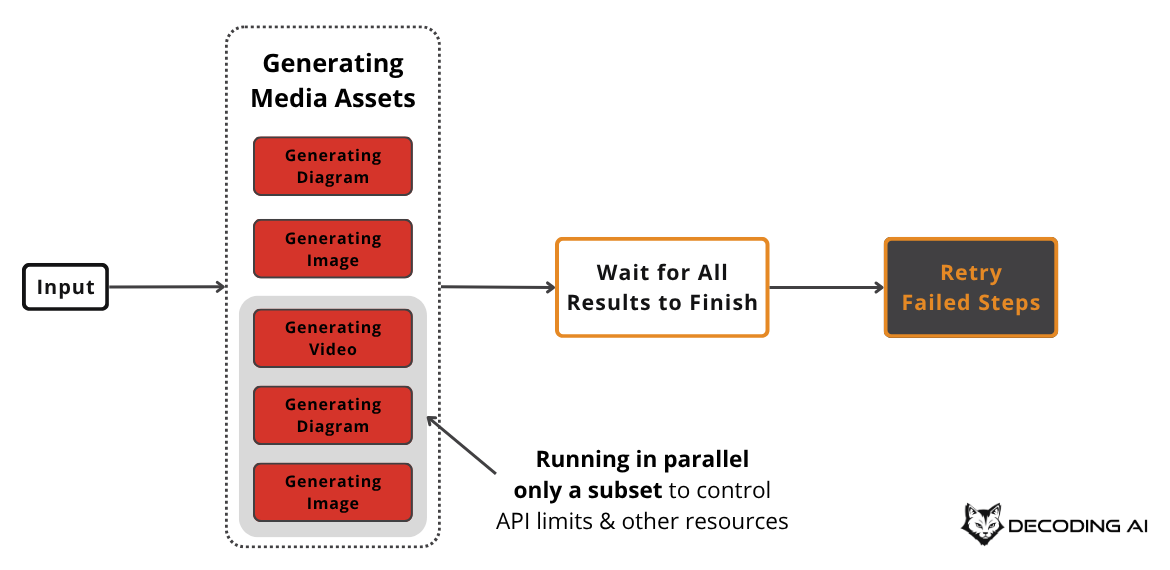
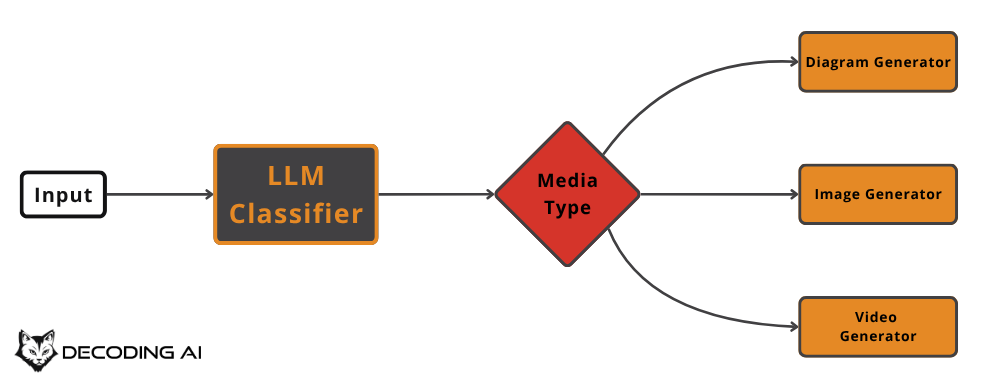
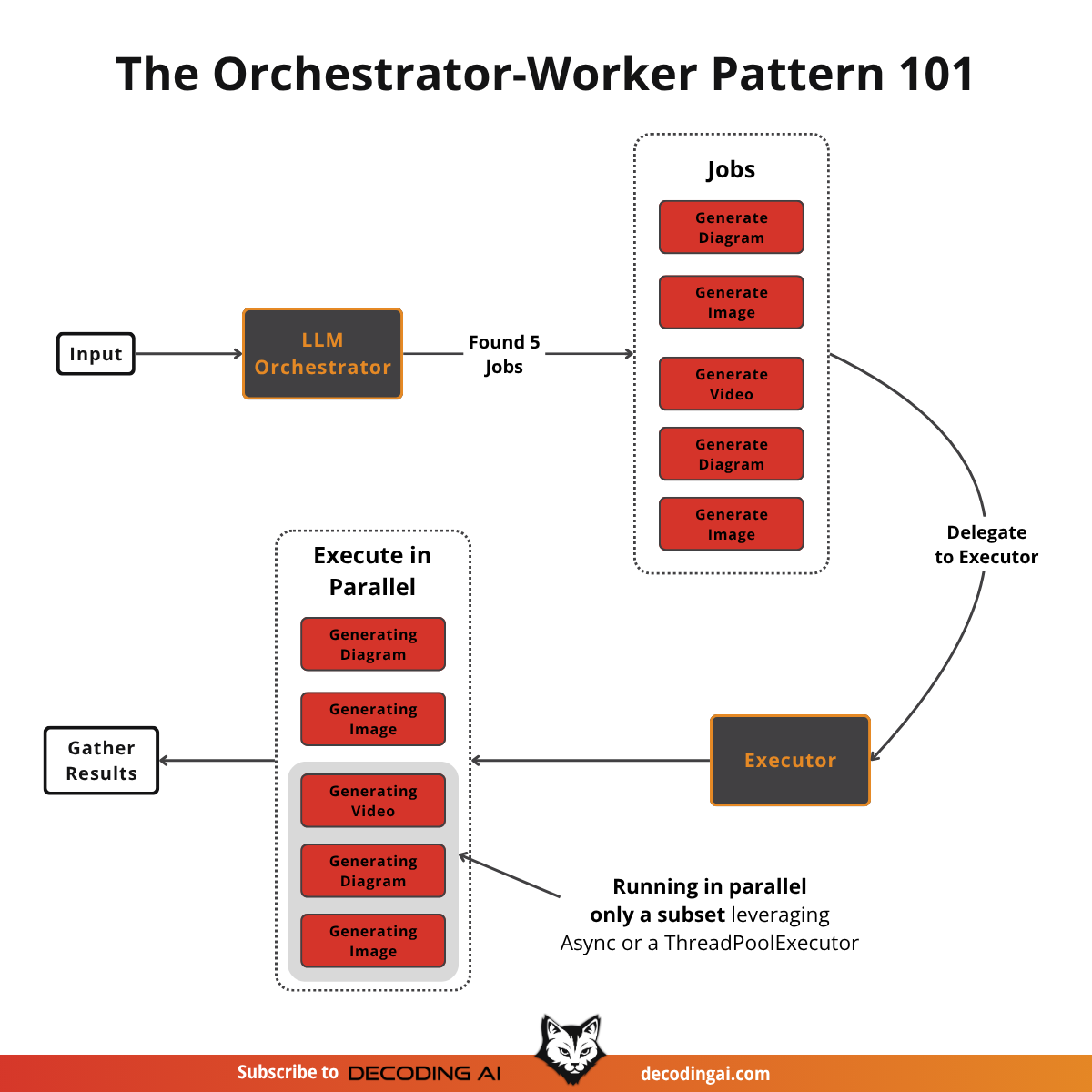
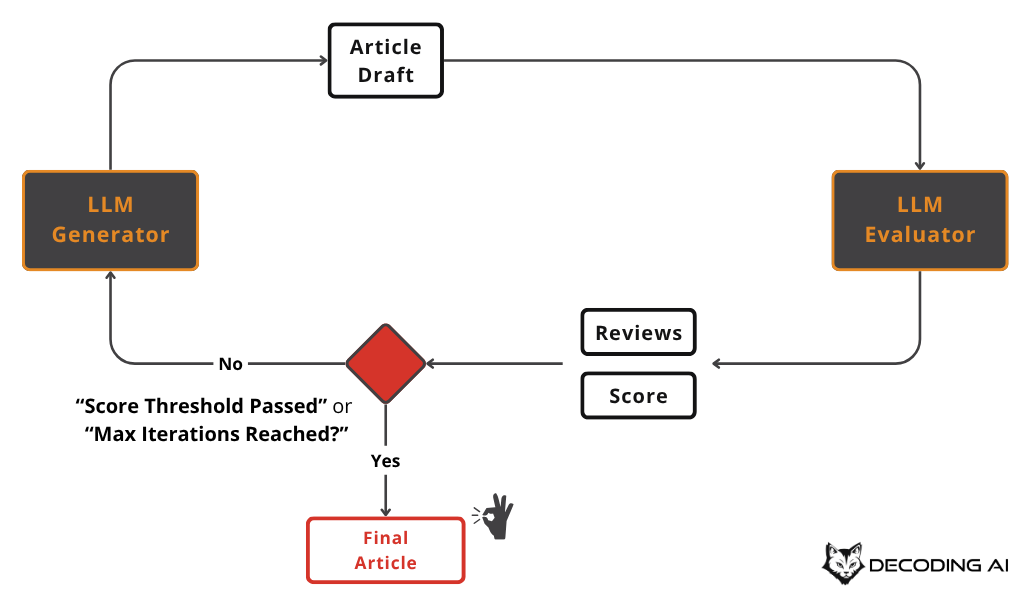

Thanks for the simple walkthrough for the good 😊
Thank you for this beautiful post.